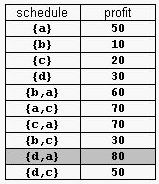POJ1456Supermarket(貪心+優先佇列)
阿新 • • 發佈:2019-02-14
Supermarket
For example, consider the products Prod={a,b,c,d} with (pa,da)=(50,2), (pb,db)=(10,1), (pc,dc)=(20,2), and (pd,dd)=(30,1). The possible selling schedules are listed in table 1. For instance, the schedule Sell={d,a} shows that the selling of product d starts at time 0 and ends at time 1, while the selling of product a starts at time 1 and ends at time 2. Each of these products is sold by its deadline. Sell is the optimal schedule and its profit is 80.

Write a program that reads sets of products from an input text file and computes the profit of an optimal selling schedule for each set of products.
| Time Limit: 2000MS | Memory Limit: 65536K |
| Total Submissions: 9103 | Accepted: 3891 |
Description
A supermarket has a set Prod of products on sale. It earns a profit px for each product x∈Prod sold by a deadline dx that is measured as an integral number of time units starting from the moment the sale begins. Each product takes precisely one unit of time for being sold. A selling schedule is an ordered subset of products Sell ≤ Prod such that the selling of each product x∈Sell, according to the ordering of Sell, completes before the deadline dx or just when dx expires. The profit of the selling schedule is Profit(Sell)=Σx∈SellFor example, consider the products Prod={a,b,c,d} with (pa,da)=(50,2), (pb,db)=(10,1), (pc,dc)=(20,2), and (pd,dd)=(30,1). The possible selling schedules are listed in table 1. For instance, the schedule Sell={d,a} shows that the selling of product d starts at time 0 and ends at time 1, while the selling of product a starts at time 1 and ends at time 2. Each of these products is sold by its deadline. Sell is the optimal schedule and its profit is 80.

Write a program that reads sets of products from an input text file and computes the profit of an optimal selling schedule for each set of products.
Input
A set of products starts with an integer 0 <= n <= 10000, which is the number of products in the set, and continues with n pairs pi di of integers, 1 <= pi <= 10000 and 1 <= di <= 10000, that designate the profit and the selling deadline of the i-th product. White spaces can occur freely in input. Input data terminate with an end of file and are guaranteed correct.Output
Sample Input
4 50 2 10 1 20 2 30 1 7 20 1 2 1 10 3 100 2 8 2 5 20 50 10
Sample Output
80 185
Hint
The sample input contains two product sets. The first set encodes the products from table 1. The second set is for 7 products. The profit of an optimal schedule for these products is 185.Source
題意: 超市裡有n個產品要賣,每個產品都有一個截至時間dx(從開始賣時算起),只有在這個截至時間之前才能賣出並且獲得率潤dy。 有多個產品,所有可以有不同的賣出順序,每賣一個產品要佔用1個單位的時間,問最多能賣出多少利潤。 解題:把產品按最後期限從大到小排,然後從最大的那個期限時間往前一天一天推,如果當前天的期限產品沒有完全賣出,就放到前一天期限,和前一天最後期限的產品一走賣,利潤大的就先賣。沒有賣出的又放到前一天去賣,這樣從大期限往小期限推,因為小期限的產品不可能在大期限時間去賣,而大期限的產品可以在小的期限去賣。#include<stdio.h>
#include<iostream>
#include<queue>
#include<algorithm>
using namespace std;
#define N 10005
typedef struct nnn
{
int p,d;
}node;
typedef struct nn
{
int p;
friend bool operator<(struct nn a,struct nn b)//優先佇列值從大到小取
{
return a.p<b.p;
}
}INT;
node ans[N];
int cmp(node a,node b)//最後期限從大到小排
{
return a.d>b.d;
}
int solve(int n,int l)
{
int maxp=0,tl,d,i,maxd;
priority_queue<INT>q;
INT pp;
i=0;
for(maxd=ans[0].d; maxd>0;maxd--)
{
for( ;i<n&&maxd<=ans[i].d; i++)
{
pp.p=ans[i].p; q.push(pp);
}
tl=0;
while(!q.empty()&&tl<l)
{
pp=q.top(); q.pop();
maxp+=pp.p; tl++;
}
}
return maxp;
}
int main()
{
int n,l,i;
while(scanf("%d",&n)>0)
{
for( i=0;i<n;i++)
scanf("%d%d",&ans[i].p,&ans[i].d);
if(n==0)
{
printf("0\n"); continue;
}
sort(ans,ans+n,cmp);
printf("%d\n",solve(n,1));
}
}
